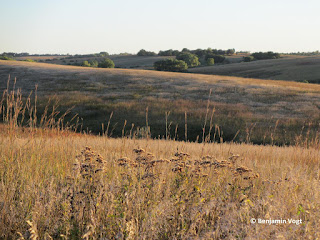"I guess the way I think of it (not based on anything other than my interpretation) is that a meadow is a grassy area as an interruption of something else--a grassy area that is substantially different than what surrounds it. And a prairie... well that's just prairie all day long. A meadow is an anomaly; a prairie is dominant."
"Meadows seem like such peaceful places; bees hum while butterflies dance above delicate wildflowers and swaying grasses. So it’s surprising to learn meadows are created by natural calamities when droughts or floods wipe out trees and vegetation. Prairies differ from meadows in that they arise in areas that don’t favor the growth of trees; they’re created and in many cases still maintained by fire. Ancient meadows were originally formed by volcanic eruptions and glacial activity. In the wild, meadows eventually give way to the surrounding forests. Nowadays, modern meadows are more likely to develop on unused agricultural grounds."
"The difference between a prairie and a meadow? There is none."
 |
| Longwood's meadow garden (pre-opening 2014) |
"I'd say you can cultivate a meadow just as you could cultivate a prairie. On the east coast, a meadow is generally regarded as any grass-dominated plant community that is created or perpetuated by disturbance. Meadows open up in forests on their own all the time."
"I'm not saying you can't cultivate either one. But typically (at least in the Great Plains (!) if a grassland has cattle or hay bales on it, it is not called a prairie (by most people). I don't know from mountains and forests. I imagine their experience with grasslands is so limited as to also limit their credibility in grassland nomenclature."
 |
| Spring Creek Prairie -- Denton, NE |
"I'd use "meadow" for a relatively moist, fairly restricted, or bounded area, perhaps with a different grass species mix than in a "prairie." I'd use "prairie" to refer to a drier area, more extensive, and with a somewhat different mix of grass species than a 'meadow.'"
"Yes. Meadows do have a more restricted scale than prairies. Good clarifications. Alpine meadows, for example, or wet meadows in the Sandhills."
" A prairie is always semi-arid and usually denotes a natural landform. Meadow has a more general meaning; it can be a grassy opening in a woodland, for example."
"Meadows are cultivated farmland. In the UK anyway."
3 comments:
thinking of Alpine meadows in Switzerland with cows and wildflowers, and making hay while the sun shines. HARD work!
I bet!
I taught that "prairie" is French for meadow; the trappers who first saw North American prairies had no word for it in their volcabulary. (Oxford English Dictionary: < French prairie tract of meadow land). Tho your discussion addresses how it is used in the US today.
Post a Comment